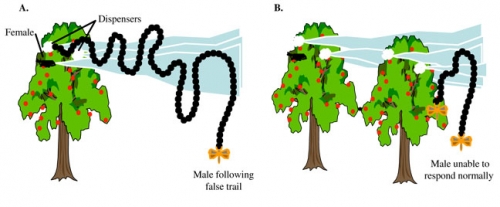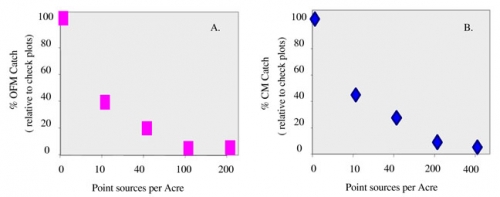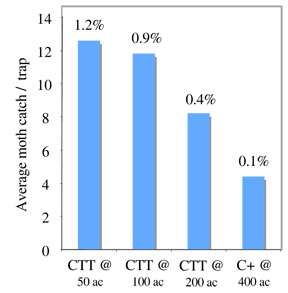Pheromone-based approaches to managing tree fruit pests in Michigan
Editor’s note: This article is from the archives of the MSU Crop Advisory Team Alerts. Check the label of any pesticide referenced to ensure your use is included.
Many fruit growers are making pheromone-based mating disruption the foundation of their pest management programs. An estimated 500,000 acres worldwide, including nearly 175,000 acres in North America, are treated with pheromone to control codling moth.
There are some features unique to mating disruption that continues to make adoption of this technology challenging for growers. Unlike most pest controls, the targeted pest is not killed. Rather, the approach entails dispensing pheromone (synthetic sex attractant) into a crop so as to interfere with mate finding. Control is thereby achieved by curtailing the reproductive phase of the pest's life cycle.
To achieve control, the grower typically must apply the pheromone treatment before the adult stage of the insect shows up, prior to knowing whether the pest is present in numbers sufficient to warrant treatment. The decision to spend up-front is made more difficult by the high cost of mating disruption products.
While insecticides can control very heavy infestations, mating disruption works best when pest densities are low, and its effectiveness declines as pest pressure increases. Under even moderate pest densities, achieving control usually requires that a grower apply supplemental insecticides to provide acceptable levels of crop protection. The need to supplement mating disruption with insecticides makes it difficult to determine how much of the success in preventing fruit injury is attributable to the pheromone treatment. The effectiveness of mating disruption is measured by the extent that moths are prevented from finding pheromone traps. Although this method better reflects the level of control provided by the pheromone treatment, using pheromone traps to measure the effectiveness of mating disruption has its own set of challenges.
Three general types of mating disruption technologies comprise the majority of commercially available products. At present, mating disruption of orchard pests is largely achieved through the manual application of reservoir-type release devices, commonly refereed to as hand-applied dispensers. Pheromone is enclosed in plastic or dispersed in synthetic polymers and slowly diffuses from these reservoirs over a period of three to six months.
Substantial efforts have been invested in other formulations to make the technology easier to use and perhaps more efficacious. Two kinds of formulations have been developed that allow the pheromone to be sprayed on the crop either by ground or air. Pheromone has been dispersed into microcapsules or beads small enough to be applied through conventional spray equipment. Pheromone also has been formulated into plastic flakes or chopped fibers that are delivered using custom-designed equipment, often with a sticker added so that the flakes or fibers will adhere to foliage. These machine-applied formulations are designed to distribute pheromone into the orchard via thousands or hundreds of thousands of small pheromone release units.
A very different approach to reducing application costs entails the formulation and release of pheromone via aerosol-emitting devices. These devices are deployed at extremely low densities of only one or two per acre. Aerosol emitters control the release of pheromone mechanically to provide a regular, predetermined emission of a large amount of pheromone.
It would be great if each of these approaches to mating disruption were equally effective and growers simply needed to choose the one that is most economical or easiest to use. However, our experience with the various mating disruption formulations suggests that this is not the case. Rather, they have different strengths and weaknesses and vary in their ability to interfere with moth mating. Thus, growers must be informed and thoughtful in choosing which of these very different approaches to use. We believe that understanding how mating disruption might actually be achieved is an important first step guiding adoption of this novel technology. With a solid understanding, growers should be in a better position to both compare technologies and use them most effectively for their particular needs.
In practice, the success of mating disruption depends on the cost-effective delivery of an appropriate blend, amount, and spatial distribution of pheromone for an extended period. Once the pheromone is delivered though, how is the behavior of males impacted to achieve mating disruption?
As illustrated in Figure 1, there are two general ways this might be achieved: 1) by competitive attraction where males are diverted from orienting to females because of competing attraction of nearby false trails emanating from pheromone dispensers, or 2) by a non-competitive means where exposure to synthetic pheromone subsequently reduces or blocks the male's ability to sense pheromone normally, and this happens without attraction. The latter could be achieved by negating the male's ability to respond to pheromone or by camouflaging the location of a pheromone-emitting female.
Figure 1.

The two principal means by which mating disruption is achieved: A) by competitive attraction
where males are diverted from orienting to females due to competing attraction of nearby false
trails emanating from pheromone dispensers, or B) by a non-competitive means where exposure
to synthetic pheromone subsequently negates the male's ability to sense pheromone normally.
Our findings over the past several years indicate that both mechanisms are operating, but that in by far the most cases competitive attraction is the key initial step. Three principal lines of evidence support the primary importance of competitive attraction. Extensive observations of male response to reservoir dispensers in the field reveal that male moths readily approach the dispensers, even in a fully pheromone-treated orchard. Additionally, mating disruption appears to be highly dependent on moth density. This is consistent with a scenario in which the capability of false pheromone sources in competing with females for searching males is easier if there are fewer individuals in the competition. If, on the other hand, the presence of pheromone in the orchard atmosphere impacted a male's ability to respond to pheromone, all males present in the pheromone-laden area should be affected regardless of how many are present. In other words, non-competitive mating disruption would not depend on the pest's density.
Finally, the effect of increasing numbers of point sources on mating disruption is predictable and the outcome should look something like Figure 2 if competitive attraction is operating. The first few dispensers have the greatest impact, but as more and more dispensers are added the effect of each diminishes. In other words, achieving 60 percent disruption takes only a few dispensers; bringing this up to 80 percent disruption requires a substantial number of additional dispensers; and levels of disruption above 90 percent require a huge bump in the number of point sources.
Figure 2.

Percent disruption of (A) Oriental fruit moth and (B) codling moth male orientation to pheromone-
baited traps in disrupted compared with non-disrupted control plots at varying point source densities.
All Oriental fruit moth plots were treated with 200 Isomate® M Rosso dispensers, but dispensers
were distributed in bundles of 20, five or two dispensers to achieve the lower point source densities.
All codling moth plots were treated with 400 Isomate® C Plus dispensers, but they were distributed
in bundles of 40, 10 or two dispensers to achieve the lower point source densities.
The remainder of this article focuses on the primary options growers have at their disposal for controlling pests by mating disruption. The discussions are largely based on our experience in Michigan and are guided by the above understanding of how mating disruption is achieved in the field and its resulting implications. The key practical implications if competitive attraction is a crucial step toward achieving mating disruption are:
- Dispenser density should be high
- Distribution should be uniform, rather than clumped
- Lots of attractive point sources provide the best disruption
Hand-applied reservoir dispensers
The tree fruit industry is probably most familiar with reservoir-type dispensers, such as plastic tubes, membranes, puzzle-pieces or spirals. Pheromone is dispensed from these devices at rates that are thousands of times greater than the release rate of pheromone from a female moth. Reservoir dispensers are hand-applied at a rate of 100-400 sources per acre, depending on the targeted species and other factors including pest density and the product's label.
Oriental fruit moth is easier to disrupt than codling moth, thus application rates of 100-150 dispensers per acre generally provide 97 percent to near complete inhibition of Oriental fruit moth mating. Our experience is that higher numbers of dispensers are needed to disrupt codling moth in apple, unless pest densities are very low. Also, codling moth disruption is not as robust. Inhibition of moth captures is often near or above 90 percent, but occasionally below 70 percent due to factors such as high pest density (Figure 3A). The more point sources the greater the impact on orientation, as documented in Figure 2. We have found that reservoir formulations having as much as a fourfold difference in release rates still provide very similar patterns of improved performance with increasing dispenser density.
Figure 3.

Percent disruption of codling moth male orientation to pheromone-baited traps in disrupted plots
compared with non-disrupted control plots in trials conducted over the past several years using:
A) a hand-applied reservoir type dispenser applied once per season, B) microencapsulated
pheromone applied at 10-14 day intervals throughout the pest’s flight, and C) a single application
of an aerosol emitter. The five trials for a particular type of dispensing system were conducted
independently of trials for the other types.
The potential benefit of applying a high number of dispensers for codling moth disruption is illustrated in Figure 4. These results, from a study conducted by Jay Brunner, Washington State University, and colleagues show a general pattern of higher point source densities providing greater inhibition of moth catch and protection from fruit injury than lower densities. The orchard perimeter is especially vulnerable to increasing incidence of fruit damage when too few dispensers are applied. Thus, it is not surprising that growers benefit the most if disruption is applied on a whole-farm basis.
Figure 4.

Average moth captures in plots treated with Isomate®
twin-tube (CTT) or C Plus (C+) dispensers at 50-400
dispensers per acre. Percentages above the bars are
the average fruit injury recorded for each treatment.
Data provided by J. Brunner, Washington State University.
Microencapsulated sprayable pheromone
The application of a sprayable disruption formulation results in the dispersion of up to a half million pheromone-containing microcapsules per acre. If each were capable of diverting the attention of males, this approach should be tremendously effective. However, each capsule releases pheromone at a very low rate, well below that of a female moth. The broadcast application of microencapsulated pheromone using an airblast sprayer appears to achieve mating disruption by camouflaging the female's signal.
For some pests, like Oriental fruit moth, the approach can yield a high level of disruption. Oriental fruit moth females release low amounts of pheromone, thus a camouflaging level of pheromone might be easier to attain. Indeed, spraying pheromone microcapsules is quite effective for Oriental fruit moth. In opting for this approach, however, the user must take into account that microcapsules release sufficient quantities to disrupt for about two to three weeks or less if hard rains dislodge the capsules from the foliage. The best approach for disrupting Oriental fruit moth with sprayable pheromone is to apply low rates at frequent intervals.
Control of codling moth using sprayable pheromone has proved more difficult. Female codling moth release pheromone at a higher rate than Oriental fruit moth females, and this likely makes it harder to disguise their plume. In trials with microencapsulated pheromone formulations, we have achieved only low to moderate levels of disruption, typically around 70 percent inhibition of moth captures in traps (Figure 3B).
The highest level of disruption is achieved when the sprayable product is applied using the “ultra low volume” approach pioneered by Tom Larson and Alan Knight in Washington State University. The improved efficacy when the treatment is made using only 1.5 gallons of water appears to result from the clustering of microcapsules that might lead to competitive attraction between clumps of capsules and females. Although the low volume approach improves the performance of sprayable pheromone, it still requires multiple applications to inhibit mate location through the season, including reapplication after a rain event, and the best disruption is achieved when pest densities are low. Thus, use of the microencapsulated formulation is a good option if you are dealing with low codling moth pressure and wish to enhance the effectiveness of an insecticide-based management program.
Aerosol emitters
Aerosol emitters are deployed at densities of one-half to two per acre, but each unit releases pheromone every 15-30 minutes at a rate equivalent to that of 50-100 hand-applied reservoir type dispensers. These devices provide a stable environment for the large volume of pheromone prior to its release and control the emission of pheromone mechanically to give a constant predetermined release rate. Researchers and practitioners in the western United States have reported high levels of orientational disruption using this high release, low point source pheromone-dispensing strategy. In field trials in Michigan, aerosol emitters have provided up to 97 percent disruption of male Oriental fruit moth orientation to pheromone-baited traps in treated plots compared with untreated controls.
The outcome in codling moth trials has not been nearly as robust, however, with only 24–75 percent disruption of male codling moth (Figure 3C). Our experience has been that disruption attained with such a low emitter density approach is insufficient to control codling moth unless pest density is very low or supplemental insecticides are applied.
Achieving complete coverage of the orchard with pheromone appears to be especially problematic with such a wide spacing of aerosol emitter type dispensers. We most often catch moths upwind of the aerosol emitters or on orchard borders. Similar to our findings with hand-applied dispensers, increasing the number of units per area appears to fill some of the holes and increase the level of disruption.
In review, there are a couple of themes from the above discussion we wish to emphasize. Oriental fruit moth is much easier to disrupt than codling moth using any of the available technologies. The grower has several good options for economical and effective management of this pest with pheromones including hand-applied, sprayable and aerosol emitter products. The best results for codling moth are generally achieved when dispensers are distributed uniformly and at a high point source density.
Regardless of the technology deployed, the outcome is always affected by pest density. Currently, the most robust approach to disrupting codling moth is to deploy a very high number of hand-applied dispensers. This strategy is especially warranted at moderate to high pest densities. In addition, combining a high point-source approach with supplemental insecticides is the best means of reducing pest densities to very low levels and can result in the ability to sustain these very low pest levels over the long term with minimal intervention with insecticides.
Toreduce material and labor costs, growers are interested in reducing dispenser density. This can be done. However, using a low number of dispensers will be most effective when pest densities are also low. Growers can explore this strategy to manage codling moth, but should be mindful that more supplemental insecticides will likely be needed than would be the case if a high number of point sources were deployed.
Dr. Gut's work is funded in part by MSU's AgBioResearch.



 Print
Print Email
Email


